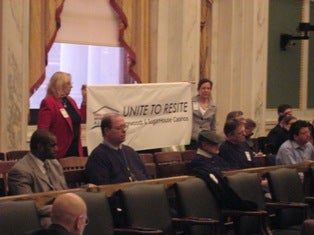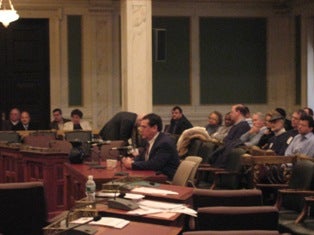Rules Committee challenges Foxwoods

March 10
By Thomas J. Walsh
For PlanPhilly
In lengthy testimony Monday, parties representing the city, neighborhood civic associations and the proposed Foxwoods Casino on Columbus Boulevard in South Philadelphia gave conflicting reports about the impact the slots parlor would have on area traffic.
Foxwoods told Philadelphia City Council’s Rules Committee that by the general retiming of traffic lights to make the flow of cars and pedestrians smoother, the current traffic situation would be improved. Council members were skeptical. And Harris Steinberg – the executive director of the organization that guided the creation of the city’s Central Delaware redevelopment plan – asked the Committee to push for a plan that was pedestrian and mass-transit friendly. Committee members heard the testimony in front of the normal crowd of anti-casino activists, who did their share of grumbling and low-key Bronx-cheering, but were generally calm.
Charles Denny, acting chief traffic engineer for the Streets Department, said that Foxwoods and the proposed Sugarhouse Casino agreed to use Market Street as the line of responsibility for traffic studies and mitigation, and that the city’s overall goal was to keep as much casino-related traffic as possible on Columbus Boulevard.
That’s more of a challenge to the Foxwoods people, he said. And, for all involved, that’s just the beginning of a topic that seems to get more complicated as the discussions move forward – or stall, as the case may be.
New or altered ramps to and from Interstate 95. Crosswalks and “refuge islands” for pedestrians. The effects on the ports for commercial trucks. Bridge traffic. Parking for cars. Parking for buses. South Philly feeder streets. Left-hand turns. U-turns. You name the behind-the-wheel issue, and it was brought up in one form or another.
Denny said the Streets Department is still working with the Pennsylvania Department of Transportation (PennDOT) on impact reports for Foxwoods’ phase I plans, and would be ready at the end of March or early in April.
Council President Anna Verna and council members Frank DiCicco and Bill Greenlee wondered why there was no mention of effects that will come with subsequent phases of development, queries that drew a smattering of applause from the gallery. Denny said it was true that large issues – such as the cost, timing and location of additional I-95 ramps – were still up in the air.
“I really don’t think it’s enough,” said Councilman John Kenney, referring to his driving and living experiences in the neighborhood. “I think you’re trying to fit a square peg in a round hole.”
At times in the early-going, there appeared to be a disconnect between the information Council wanted to hear and that which the Streets Department had prepared regarding the first phase of construction.
Later, testimony would help illustrate why answers were so difficult to pin down. But Maureen Garrity, a spokeswoman for Foxwoods, said some of the disparity in expectations at the hearing had to do with site design plans versus traffic impact reports. The two are different issues with different timelines, she said, and currently, the casino is only concerned with getting phase I plans and studies in shape.
By the Numbers
Jeremy Alvarez, an associate planner with Stantec Consulting, a Philadelphia company hired by City Council to look independently at waterfront casino traffic scenarios, also testified. Alvarez described service loads and “volume to capacity” figures for 15 intersections during nine different periods in a given week. He spoke of their accompanying potential for increasingly “significant delays” in traffic over the 10 years following an anticipated 2009 Foxwoods opening. The casino company underestimated the amount of “trip generation” at the location of a “very fragile traffic system,” he said, adding that a Foxwoods software error may have contributed to discrepancies.
Nonsense, said Carl Primavera, lead attorney for Foxwoods, who later testified that Stantec used a new computer program that he was not aware of until two days ago. “We are using the PennDOT system,” Primavera said, which is “the gold standard” for traffic impact studies. “We’re standing by our report. PennDOT is standing by our report.”
Addressing Alvarez, DiCicco voiced skepticism about Foxwoods’ assertion that its mitigation would actually make traffic on Columbus Boulevard better. “I’ve never been able to comprehend that,” he said. Later, when speaking to Greene, he repeated those doubts several times. He asked Alvarez if further study was recommended, and Alvarez responded “Yeah, definitely.”
Another traffic study was presented by Frank Tavani, a Chester Springs, Pa. engineer and planner, representing the Philadelphia Neighborhood Alliance. Tavani said that neither Foxwoods nor Sugarhouse considered the other casino for their own traffic studies. He said Foxwoods is authorized to have 5,000 slot machines, but its current impact predictions only reflect 3,000 – again, a reminder that the idea of phased planning for the casino is confusing officials and stakeholders.
“It would seem this location is fundamentally incompatible,” Tavani said. “When there’s a mandate that’s open-ended, that means it’s open to interpretation.” He said he felt that it was disingenuous to maintain that “25,000 vehicles a day with just a few improvements” would improve traffic matters.
Before Foxwoods’ traffic presentation was presented, the committee heard from members of the Pennsport and Queen Village neighborhood groups. They said traffic was already “maxed out” along the Delaware River waterfront, especially in a location that has a Wal-Mart, a movie multiplex, Target, Ikea and other big-box retail, with nightclubs, strip joints and restaurants.
Philadelphia Neighborhood Alliance comments with a sign
Bumper to Bumper
“We’ll probably agree to disagree” with the preceding testimony, said Primavera, as he and traffic analyst Jeff Greene of Orth-Rogers Associates prepared to brief the committee.
Greene said his latest study went above and beyond what his client was obligated to provide, using an “extensive amount of traffic counting” and by being conservative, through overestimation, about annual increases in traffic that PennDOT would assume with or without the gaming hall.
After that short grace period, Greene could not again keep momentum. He started to explain weekend traffic counts and increases that would be caused by Foxwoods, but DiCicco – and at times Verna, Kenney and Greenlee – regularly interrupted him, seeking the context and actual numbers of current traffic. DiCicco also criticized the times of the year that two 2006 and 2007 Foxwoods studies were conducted. “Everybody knows that January and February are the slowest retail months,” he said.
“Jeff, talk about protocol,” encouraged Primavera. Greene looked from the attorney to the committee and said, “Basically it’s about counting cars.”
The mildly hostile crowd got a bit restless as DiCicco, in whose district the two casinos would be situated, expressed more incredulity over what Greene said next. The consultant said that many of the predicted figures quoted in the latest study came from data collected at Foxwoods’ rural Connecticut operation (a full-scale casino that is said to be the biggest gaming hall in the world); a transportation engineering magazine article; Las Vegas traffic impact studies; and information from Delaware Park, south of Wilmington, Del., which is a racetrack with slots.
“Isn’t that a completely different environment than Delaware Avenue?” asked DiCicco, in a tone that could have been easily been construed as rhetorical. Greene conceded “a point well taken,” and said more details were needed of anticipated people per vehicle, times of arrival and trip generation.
When Greenlee asked how the Foxwoods study came by its percentage figures for traffic volume, Greene said he used the online services Google Maps or Mapquest for the quickest routes to the site from different points around the region. He also tested times based on the commutes of people in his firm, he said, and wrote some of it from his general knowledge of the area.
Acknowledging that Greene was in a tough spot, DiCicco asked if he could contrast the Columbus Boulevard impact with what he called the “horrible” gridlock that is the norm in Atlantic City. “Maybe I shouldn’t [ask that], but you guys are talking about Connecticut, so I have to talk about Atlantic City.”
Greene was on firmer ground when he spoke of a need for better traffic technology, much of which Foxwoods would pay for. It includes fiber-optic cables the length of the waterfront, and signal timing that could change on a dime when an accident on I-95 or an incoming freight train called for it. This track “railway preemption” was something the casino is working on with the Conrail and Norfolk-Southern rail lines, he said.
All of it is contingent on Foxwoods attaining a highway occupancy permit from the city and from PennDOT, Primavera reminded the committee.
Pier-to-Pier Review
Another issue that dominated discussion was the casino’s potential impact on rail freight and general trucking to the south of the site, at Philadelphia’s loading docks. Greene said the company was working with the railroads closely on those issues, but again, DiCicco was adamant about having his doubts heard.
“What if they refuse? My experience with railroads [is that] they are not very cooperative,” DiCicco said. After hearing assurances from Greene on the matter, with more on technical advances that could offset uncooperative railroads, DiCicco shook his head and repeated why he was dubious.
Kenney joined in, saying he found it “extremely counterintuitive” that the Foxwoods plan would actually save money for port operators. Greene insisted that yes, based on costs per hour for operating a truck, it would result in modest savings for them.
Proceedings, which started at 10 a.m. Monday, stretched on long into the afternoon. Representatives from the International Longshoremen’s Association, the Pennsylvania Downtown Association and a former Foxwoods Connecticut worker all testified against the development of the casino at its proposed location. An economic impact consultant was expected to testify on behalf of Foxwoods.
The traffic-related testimony was preceded by a report given by Steinberg of PennPraxis, which has led the construction of a long-term vision of the Central Philadelphia waterfront. Steinberg stressed that only about two miles of that waterfront is public property, and that City Council and the new Nutter administration would have to be diligent in setting the tone – not to mention implementing the proper zoning changes – for the next 25 to 30 years.

Penn Praxis’ executive director Harris Steinberg
Steinberg’s organization does not critique development plans. But he urged the Rules Committee to keep pedestrian-friendly plans at the forefront of their approval process, especially because the areas where casinos are planned are what he called increasingly urbanized. He said mass transit improvements, such as light rail service, could be built upon existing railway infrastructure.
Giving up that right of way is a real danger, Steinberg said. “At the moment, the deck is stacked against us,” he said, acknowledging that he had perhaps used unfortunate analogy. Because decisions like that are often based on the density of vehicular and pedestrian traffic, he said it becomes a “chicken-and-egg” scenario regarding the planning of a casino, where the aim is high density.
Contact the reporter at thomaswalsh1@gmail.com
Read written testimony from the hearing:
WHYY is your source for fact-based, in-depth journalism and information. As a nonprofit organization, we rely on financial support from readers like you. Please give today.



